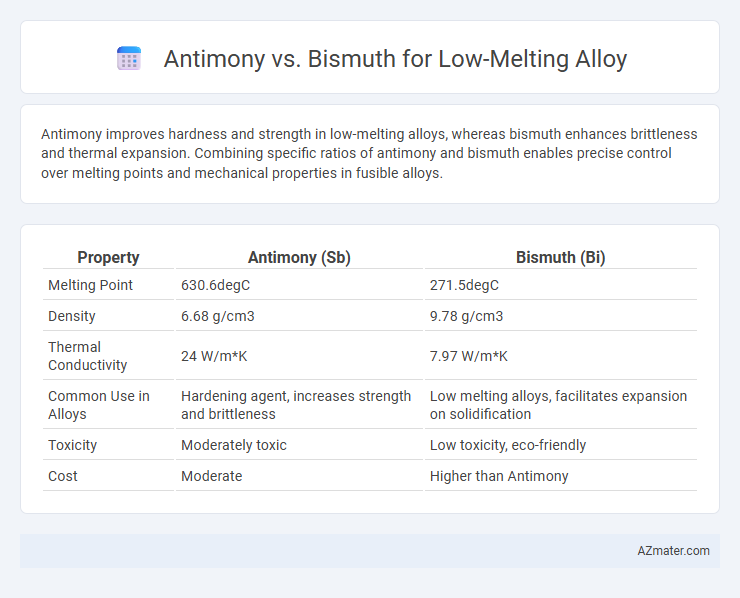Antimony improves hardness and strength in low-melting alloys, whereas bismuth enhances brittleness and thermal expansion. Combining specific ratios of antimony and bismuth enables precise control over melting points and mechanical properties in fusible alloys.
Table of Comparison
| Property | Antimony (Sb) | Bismuth (Bi) |
|---|---|---|
| Melting Point | 630.6degC | 271.5degC |
| Density | 6.68 g/cm3 | 9.78 g/cm3 |
| Thermal Conductivity | 24 W/m*K | 7.97 W/m*K |
| Common Use in Alloys | Hardening agent, increases strength and brittleness | Low melting alloys, facilitates expansion on solidification |
| Toxicity | Moderately toxic | Low toxicity, eco-friendly |
| Cost | Moderate | Higher than Antimony |
Introduction to Low-Melting Alloys
Low-melting alloys are critical in applications requiring precise melting points below 300degC, commonly used in soldering, fuses, and casting. Antimony and Bismuth are two essential metallic elements in these alloys; Antimony improves hardness and strength while maintaining low melting characteristics, whereas Bismuth provides excellent thermal expansion properties and non-toxicity. The combination or individual use of these elements allows for tailored melting ranges and mechanical properties suited to electronic, safety, and engineering industries.
Antimony: Properties and Applications
Antimony, with a melting point of 630.6degC and excellent hardness, enhances the strength and wear resistance of low-melting alloys, making it ideal for applications in type metal, solder, and bearings. Its ability to improve alloy fluidity and reduce shrinkage distinguishes it from bismuth, which primarily lowers melting points but offers less mechanical reinforcement. Antimony's chemical stability and corrosion resistance make it a pivotal component in fire retardants, lead-acid batteries, and ammunition alloy formulations.
Bismuth: Properties and Applications
Bismuth exhibits a low melting point of 271.5degC, making it ideal for low-melting alloys used in safety devices and fusible plugs where precise melting behavior is critical. Its non-toxicity and excellent thermal conductivity enhance applications in fire detection and medical screw alloys. Bismuth-based alloys also provide superior dimensional stability compared to antimony, enabling reliable performance in precision casting and electrical fuses.
Melting Points: Antimony vs Bismuth
Antimony has a melting point of 630.63degC, making it significantly higher than bismuth's melting point of 271.5degC. In low-melting alloys, bismuth allows for easier melting and better castability at lower temperatures compared to antimony. The substantial difference in melting points influences their selection in alloys where temperature sensitivity and melting range are critical.
Toxicity and Environmental Impact
Antimony, commonly used in low-melting alloys, poses significant toxicity risks including respiratory irritation and long-term carcinogenic potential, raising concerns for occupational safety and environmental contamination. Bismuth offers a safer alternative with substantially lower toxicity, minimal bioaccumulation, and reduced environmental hazards, making it preferable in eco-friendly alloy formulations. Both elements influence alloy melting points and performance, but bismuth's favorable health profile supports its increasing adoption for sustainable metal applications.
Alloy Performance: Antimony vs Bismuth
Antimony enhances the mechanical strength and creep resistance of low-melting alloys, making them suitable for high-stress applications, while bismuth improves thermal conductivity and provides excellent corrosion resistance. Alloys containing antimony exhibit higher hardness and better dimensional stability at elevated temperatures compared to bismuth-based alloys. In contrast, bismuth alloys offer superior machinability and environmental friendliness due to their non-toxic nature and lower melting points.
Cost and Availability Comparison
Antimony is generally more abundant and less expensive than bismuth, making it a cost-effective choice for low-melting alloys used in fire safety devices and soldering applications. Bismuth, while pricier due to its relative scarcity and higher extraction costs, offers non-toxic properties and excellent thermal expansion control, suitable for medical and cosmetic applications. Evaluating cost and availability, manufacturers often prefer antimony for large-scale production, while bismuth is reserved for specialized, environmentally sensitive uses.
Industrial Use Cases
Antimony enhances hardness and mechanical strength in low-melting alloys, making it ideal for applications in soldering, casting, and firefighting devices where durability under stress is critical. Bismuth offers excellent thermal expansion properties and non-toxicity, widely used in medical devices, fire safety systems, and environmentally friendly solders. Industrial use cases leverage antimony for structural reinforcement, while bismuth provides safer alternatives in electronics and precision casting.
Recent Advances in Low-Melting Alloys
Antimony and bismuth are key elements in recent advances in low-melting alloys due to their favorable melting points of 630degC and 271degC, respectively, which enable precise thermal management in applications like soldering and thermal fuses. Bismuth-based alloys have gained prominence for their non-toxic, environmentally friendly properties and excellent lubrication characteristics, while antimony enhances mechanical strength and hardness when alloyed with lead or tin. Recent innovations focus on optimizing these element ratios to tailor melting temperatures, improve corrosion resistance, and enhance electrical conductivity for next-generation electronic and industrial uses.
Choosing the Right Metal for Your Application
Antimony and bismuth offer distinct advantages for low-melting alloys, with antimony providing enhanced hardness and strength while bismuth ensures superior machinability and environmental safety due to its non-toxicity. Bismuth alloys typically melt around 138degC to 142degC, making them ideal for precision casting and fusible plugs, whereas antimony-containing alloys tend to have higher melting points and better wear resistance. Selecting the right metal depends on application requirements such as melting temperature range, mechanical properties, and environmental considerations.

Infographic: Antimony vs Bismuth for Low-melting Alloy
 azmater.com
azmater.com